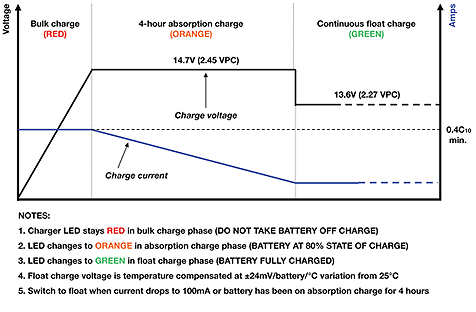globalrider
Alps Adventurer
Without verifying the numbers I suspect that most any 12 v charger can charge most any 12 v battery to somewhere between 80% and 90% (or maybe a little higher) of full charge.
True. Batteries reach 85 to 90% of full charge quickly. Its the last 10 to 15% that takes far longer to charge. That is why that stage is called "bulk charging" which is the constant current phase.
The penalty the owner pays for using less than the optimal charger for a specific battery is probably less than full charging and maybe reduced battery life.
And possibly overcharging. Both cases shorten battery life.
Charge voltage depends on the battery temperature and ideally a battery charger should take cut-off voltage into account based on that. Unfortunately, our low priced chargers do not have that feature. The CTEL MULTI US 3300 has a two stage voltage cut-off that you select; either 14.4 or 14.7, the later is used for temperatures under 41F (your cold garage) or for certain AGM batteries that need the higher charge voltage.
We have a Cadex charger at work; there are three leads...positive, negative and a thermocouple temperature probe. Big coin though!
The following East Penn Technical Manual for GEL and AGM Batteries discusses battery voltage vs temperature (page 11) and battery life vs overcharging (page 4).
In a garage at 32F batteries should be charged to about 15V. Down in Texas in the middle of summer, that voltage should be about 14V.
And in the end, since our batteries are charged by the alternator most of the time, which I doubt temperature compensates, why worry about it.
What I pay the most attention to is the peak charging rate allowed.
And the general and safe rule of thumb is 10% of the Ah capacity. In our cases, thats usually under 2A.



 ro fry the RT's electrical system?
ro fry the RT's electrical system?